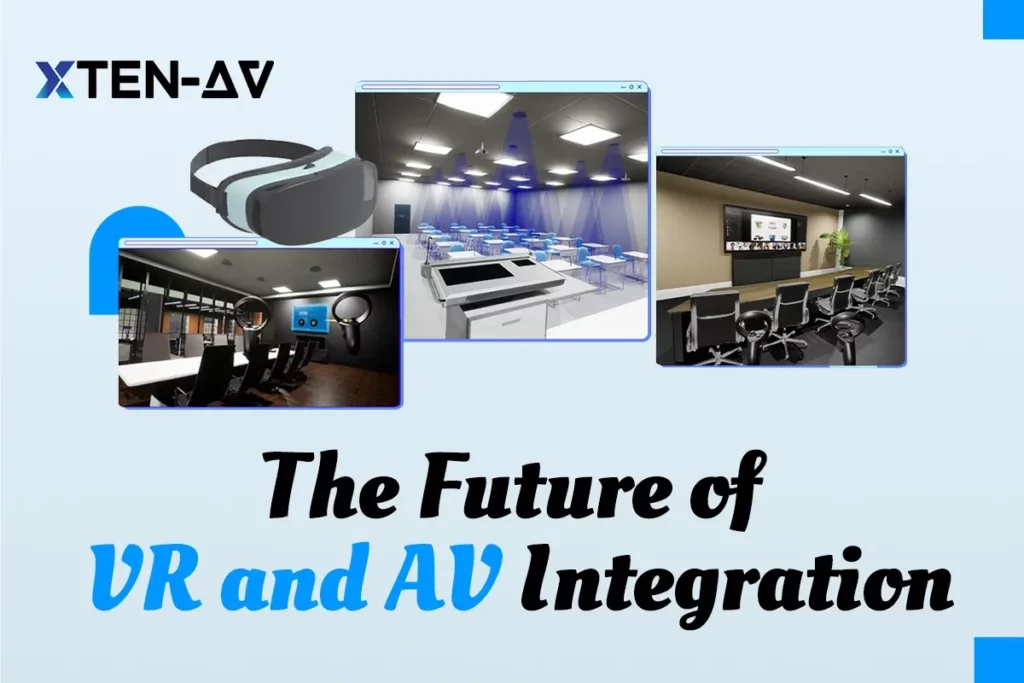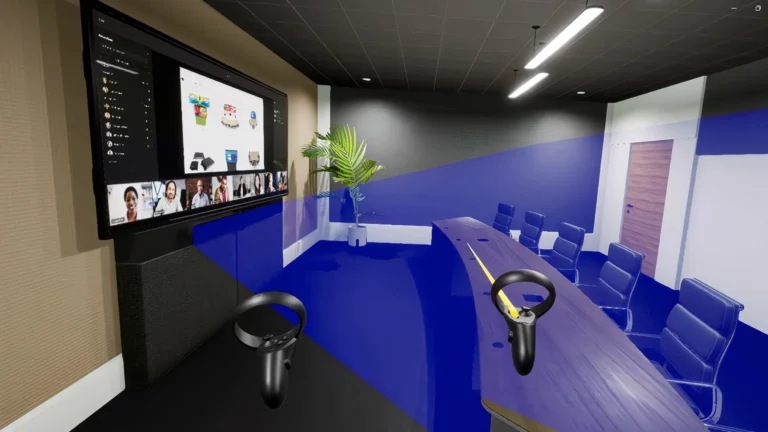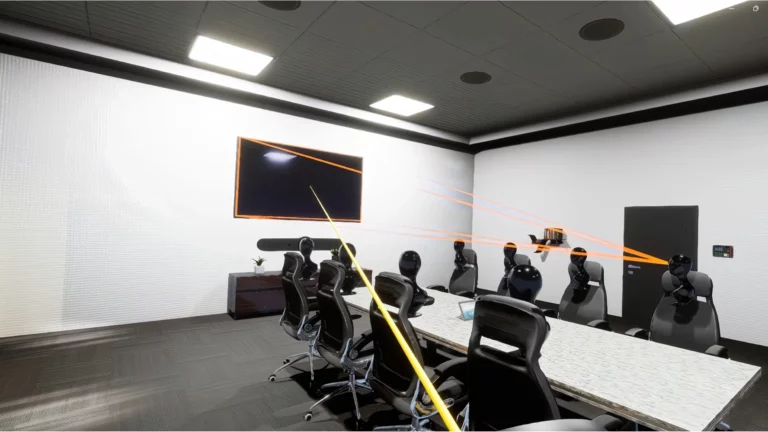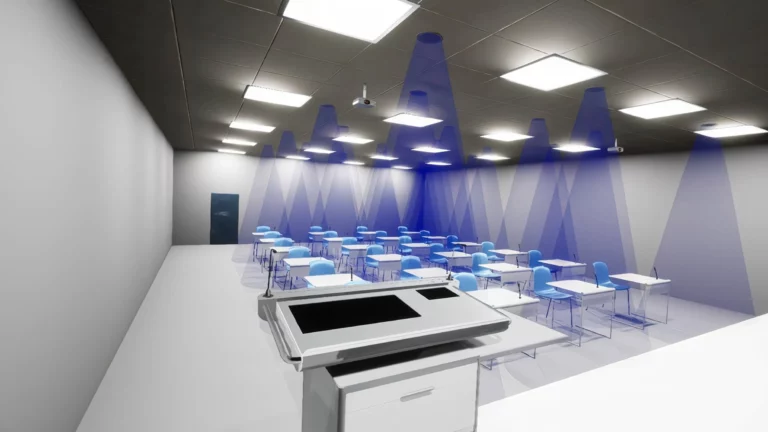AV Integration and VR: Trends, Challenges, and Opportunities
Technology integrates into every corner of life. They upgraded everything, from smart home devices to virtual assistants. Now, audio and visual systems follow suit through AV integration. Strap in because immersive technologies like VR and AV are about to take AV integration to the next level. The possibilities are exciting, so read on to learn all about the developing world of audio-visual integration!
Unlock the Power of VR Technology with XTEN-AV: Effortless AV Integration
The all-in-one solution for your AV needs
Transform your audio-visual experience with XTEN-AV.
No Credit Card required
What is AV integration?
AV integration combines audio, video, and control systems into a unified solution for seamless communication and collaboration. AV integrators design, install, and maintain these systems to create an immersive experience.
Key Components of AV Integration
The core components of any audio video integration include:
- Audio systems: Speakers, microphones, amplifiers, etc. These handle sound recording, playback, and distribution. Video systems use projectors, displays, cameras, etc., for image and video capture, processing, and display.
- Control systems: Touch panels, control processors, software interfaces, etc. These allow users to control and automate the audio and video systems.
- Infrastructure: It includes cabling, mounts, and racks. It connects and supports audio, video, and control components.
Benefits of audio visual integration
Effective audio-visual integration provides many benefits:
- Enhanced presentations and communication: AV systems improve conferences, lectures, and collaborative meetings.
- Increase productivity: Integrated AV solutions allow seamless collaboration. They let employees connect and share information.
- Impressive experience: Carefully designed AV systems create an immersive environment. It engages audiences and participants.
- Reduced costs: Well-integrated AV systems are more energy-efficient and easier to maintain, as their components work together.
- Future-ready: AV integration enables the efficient implementation of new technologies, like VR, AI, and IoT, as needs change.
Additional Emerging AV VR Integration Trends
Here are the additional emerging AV/VR trends:
Artificial Intelligence and Machine Learning
AI and ML will impact the future of AV integration, including virtual reality. These AV technologies can automate processes, enhance system performance, and predict user behavior.
For example, AI-powered AV systems could adjust lighting, sound, and video based on room occupancy, noise, and preferences, ensuring an optimal VR experience. ML algorithms can analyze user interactions in virtual environments and tailor content and interactions, creating a more personal VR journey.
The Internet of Things and Smart Spaces
The Internet of Things (IoT) connects devices and sensors, allowing them to communicate and exchange data. AV systems can use this technology to create “smart spaces.” These spaces adapt to users’ needs in real time, in the real world, and in VR.
Here’s a VR meeting room where lighting and temperature adapt to users’ preferences. In the real world, IoT could manage energy use in buildings and tune a room to improve VR sound.
5G Connectivity and Edge Computing
5G connectivity and edge computing will revolutionize AV integration, including VR applications. 5G has fast data transfer and real-time processing. It allows for better video streaming. It also helps with video calls and collaboration for remote teams in virtual environments.
Edge computing processes data closer to its source. It reduces latency and improves the VR apps’ responsiveness. This means VR experiences will be smoother and more realistic. They will have less lag and cause less sickness.
How Virtual Reality (VR) is Transforming AV Integration?
Virtual reality (VR) is one of the most exciting frontiers in AV integration. VR technology lets you immerse yourself in a virtual world. It does this through headsets that block your surroundings. The future of VR and AV integration is bright, with many possibilities.
More Immersive Experiences
VR is poised to take AV integration to the next level by facilitating hyper-realistic virtual experiences. Attend a virtual conference. You will feel like you are there or working on a project through a shared virtual space. It mimics a real office. VR makes these immersive interactions possible. It does so through great graphics, 3D audio, and fast interfaces.
Smooth integration of AV components
Creating great VR requires AV components, including visuals, audio, lighting, and acoustics. These components must work together, requiring tight integration. This includes high-res displays, 3D sound, haptic feedback, and tracking sensors. Combining and calibrating all these elements can transport you to another place by engaging your senses.
AI and predictive analytics
Artificial intelligence (AI) and predictive analytics enhance VR experiences through personalization and automation. For example, AI can detect how you act in a virtual environment and adjust the experience to your preferences in real time. If you spend more time looking at certain objects or with specific people, the system may make those elements more prominent. AI can also predict how lighting, audio, and other factors must change. Your location and activities in a virtual space determine this.
The future of VR and AV integration is exciting. As technology advances, virtual experiences will become more immersive and personalized. VR may transform the way you live, work, learn, and interact with one another. The possibilities for enhanced virtual collaboration, education, training, and more are endless.
AV and VR Integration Challenges and Future Outlook
Here are the challenges of AV/VR integrations:
- Cost and Accessibility: AV VR is still expensive. This makes it inaccessible to many groups.
- Content Creation: Creating high-quality, engaging VR content requires significant resources and expertise, which can challenge many developers.
- Technical Limitations: VR technology still faces technical limitations, such as latency, resolution, and compatibility issues, which can affect the user experience.
- User adoption: Users must adapt to new interfaces and interactions for VR. This can be a barrier to adoption for some.
- Security: VR technology raises concerns about data security and privacy. This is especially true in apps where sensitive information is shared or accessed.
Here are the future developments in the VR AV space:
- Advancements in VR hardware: Improvements in VR AV hardware, such as higher resolutions and lower latency, will further enhance the user experience.
- Increased AI Integration: AI will continue to play a crucial role. It will enhance VR experiences, improve user interactions, and optimize system performance.
- Expansion into New Industries: VR will be applied in new industries, such as healthcare, education, and design, to improve training, education, and collaboration.
- Cloud-Based Solutions: Software for managing AV projects in the cloud will keep streamlining workflows. It will also enable remote management. This will make it easier for organizations to add VR technology.
- Metaverse Development: The metaverse is a virtual world combining VR/AR and social media. It will expand the possibilities for virtual reality.
XTEN-AV: Pioneering AV Design and Sales with X-VRSE VR Technology
XTEN-AV is a leading AV automation innovator. It has launched X-VRSE. It is a groundbreaking VR solution. It solves many of these problems.
- Immerse users in a virtual environment tailored for AV setups, X-VRSE delivers unparalleled realism and immersion.
- X-VRSE helps users visualize AV equipment, acoustics, and lighting in a virtual space, eliminating the need for physical mockups.
- Bridging the gap between concept and reality, X-VRSE allows clients to experience their AV designs in a virtual world, enhancing their understanding and appreciation of proposed solutions.
- We revolutionize sales presentations and demos by delivering an unparalleled immersive and interactive experience.
- Your AV designs are future-proofed with X-VRSE’s seamless integration with emerging technologies like AI, IoT, and 5G.
Join us as we pave the way for the future of AV design and sales with X-VRSE at the forefront! This software empowers AV pros by allowing them to create previously thought impossible immersive experiences. Book a demo with X-VRSE to experience the future of VR in AV design and sales firsthand
AV Design Mastery + Winning Proposals = 10x Productivity!
- Automatic Cable Labeling & Styling
- 100+ Free Proposal Templates
- Upload & Create Floor Plans
- 1.5M Products from 5200 Brands
- AI-powered ‘Search Sense'
- Legally Binding Digital Signatures
No Credit Card Required
Conclusion
The integration of AV and VR is poised to revolutionize how you experience content, collaborate, and communicate. While challenges remain, the potential benefits are immense, which has a growing appetite for immersive technologies. XTEN-AV’s X-VRSE is a prime example of how innovation drives the future of VR AV integration. It makes it more accessible and user-friendly for everyone.
To learn more about how X-VRSE can transform your AV design and sales process, visit our website or contact our team for a demonstration.
FAQs
AV technology encompasses electronic media that combines audio and visual components. This includes speakers, microphones, displays, projectors, cameras, and the infrastructure connecting them. Many settings use AV integration, from home entertainment to professional presentations and virtual reality.
In audio-video virtual reality (AV VR), audio is a critical component that enhances the immersive experience and complements the visual elements. It involves the use of spatial audio techniques to create a realistic soundscape that matches the virtual environment. This includes simulating the direction, distance, and movement of sound sources, as well as environmental effects like reverberation and occlusion.
AV work involves designing, installing, integrating, and maintaining audiovisual systems. AV VR professionals ensure that the audio and video work together. They do this to deliver a great user experience. They also keep up with the latest technologies, like virtual reality (VR). They use them to create immersive and engaging environments.
The future of virtual reality technology is bright, promising more immersive and realistic experiences. Advancements in spatial audio, haptics, and brain-computer interfaces will further enhance sensory immersion. AV VR will expand beyond entertainment into fields like education, healthcare, and social interaction, transforming how we learn, work, and connect.
Extended Reality is an umbrella term encompassing virtual reality (VR), augmented reality (AR), and mixed reality (MR). In AV VR, XR expands possibilities by integrating virtual elements with real-world environments, enabling more interactive and immersive experiences for events, presentations, and training.
VR is revolutionizing AV integration by offering immersive, interactive experiences. It enables virtual site visits, product demos, and training simulations, reducing costs and improving engagement. Additionally, VR allows for remote collaboration on AV projects, enhancing efficiency and accessibility for global teams.
VR in AV enhances audience engagement and retention through immersive experiences. It enables effective visualization of complex designs and concepts, leading to better decision-making and client satisfaction. Additionally, VR provides cost-effective solutions for training, product demonstrations, and marketing campaigns.




